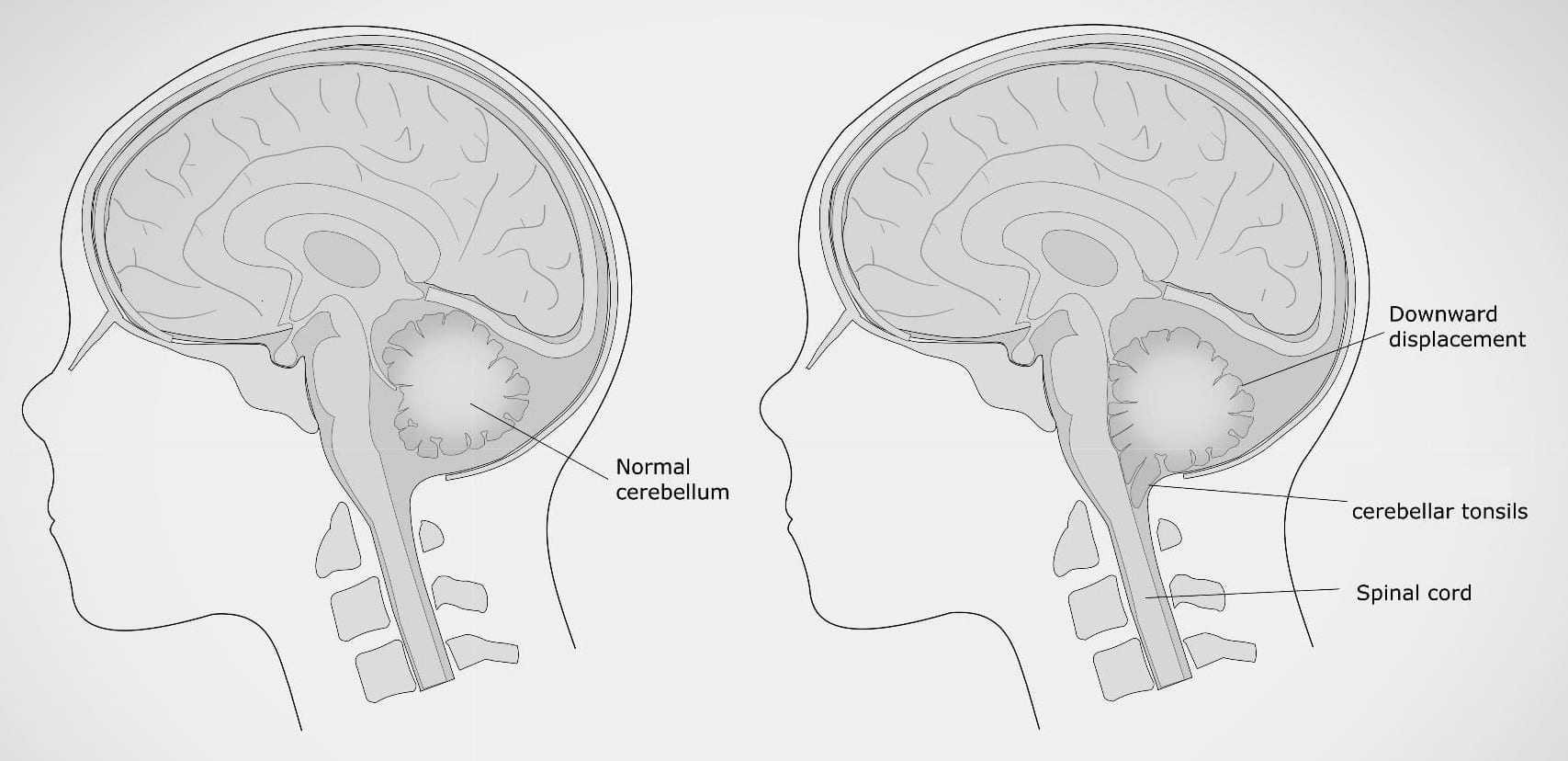
Chiari Malformation
A Chiari malformation is usually considered a congenital (present at birth) abnormality. It occurs when a part of the brain, known as the cerebellum, is pushed down into the foramen magnum, an area which is located where the skull joins the cervical spine.
Chiari malformations can be divided into four types.
- Type I is the most common and mildest form. The lowest part of the cerebellum is positioned below the level of the base of the skull. This type may be discovered at any age from infancy through adulthood. It is often characterized by headaches.
- Type II affects 0.02% of births. It is more prevalent in girls then boys, and is only seen in infants who are born with myelomeningocele or spina bifida, a neurological condition that causes a portion of the spinal cord and the surrounding structures to develop outside, instead of inside, the body.
- Type III is very uncommon. This is when a portion of the cerebellum or spinal cord protrudes, or herniates through a bony opening in the skull or cervical spine. Historically this has a poor prognosis; however with improvements in technology, surgical techniques as well as early intervention and physical therapies, outcomes are more promising.
- Type IV is when the cerebellum and related brain tissue fail to develop normally. Resulting in extreme cerebellar hypoplasia.
Most Chiari malformations are congenital, developing in fetal life or infancy. They are often associated with a structural defect in the brain, skull or spinal column, or can occur secondary to cysts or tumors in the brain.
Chiari malformations can be known to run in families. There may a genetic link, but this is not clear, and is an active area of research.
Some individuals can go a lifetime without experiencing symptoms of their Chiari malformations. Others are unable to participate in everyday activities because their symptoms are so severe.
A few common symptoms include:
- Headaches
- Neck/back pain
- Rapid, back and forth, eye movement
- Poor feeding in infants
- Swallowing difficulties
- Breathing problems
- Decreased strength
Symptoms of Chiari may resemble other medical conditions. Always consult your doctor regarding a diagnosis.
The diagnosis of Chiari malformation may occur at any age from infancy through adulthood. Chiari Malformation type II, III, & IV are often diagnosed just before or after birth.
The diagnosis is made after the onset of specific signs and symptoms are reported which would lead a physician to order diagnostic testing.
When symptoms are reported in children, The pediatrician often obtains a complete prenatal and birth history, and may also ask if there is a family history of any medical problems. The physician will also ask about developmental milestones, such as the age the child sat up, crawled, or walked. Any reported developmental delays may require further medical follow up for underlying problems. During the examination, a measurement of the circumference of the child’s head is taken and compared to a scale that can identify normal and abnormal ranges. Diagnostic testing will be required to make the diagnosis of Chiari Malformation.
Diagnostic tests:
X-rays: Uses invisible electromagnetic energy beams to produce images of internal tissues, bones, and organs onto film.
CT or CAT scan: Computed tomography scan is imaging that uses a combination of X-rays and computer technology to produce horizontal, or axial, images (often called slices) of the body. A CT scan shows detailed images of any part of the body, including the bones, muscles, fat, and organs. CT scans are more detailed than general X-rays.
MRI: Magnetic resonance imaging uses a combination of large magnets, radiofrequencies, and a computer to produce detailed images of organs and structures within the body.
Genetic Counseling: May be offered by your physician.
There are few different treatment options available. Specific treatment for a Chiari malformation will be determined based on:
- Your age, overall health, and medical history
- The severity of your symptoms
- Additional findings on exams
- Your tolerance for specific medications, procedures, or therapies
- Your personal goals
Treatment Options include:
Medical management: A conservative approach to Chiari malformation would include frequent physical examinations and diagnostic testing to monitor the growth and development of the brain, spinal cord, skull, and backbones, pain management and physical therapy. If symptoms became more sever or debilitating, surgical intervention may be recommended.
Surgical intervention: Surgery can relieve increased pressure inside the head or neck resulting in a reduction or elimination of symptoms. Through surgery we can drain excess cerebral spinal fluid from the brain that may be contributing to the symptoms, or decompress the areas that are creating crowding in the brain. Pain management and physical therapy would be recommended in conjunction with any surgical intervention.

Syringomyelia
Syringomyelia is a rare disorder that causes a cyst to form in your spinal cord. This cyst, called a syrinx, may grow in width and length over time, destroying part of the spinal cord. Damage to the spinal cord from the syrinx can cause symptoms such as pain and weakness in the back, shoulders, arms or legs, headaches, and inability to feel hot or cold.
Surgical intervention is often recommended and has proven effective in relieving symptoms and preventing further damage to the spinal nerves.